source: www.youthwork-practice.com | 2000 Games, Devotions, Themes, Ideas and more for Youth Work
only for private using
Wrestling, scuffle & fighting

Scuffling and wrestling
©: www.youthwork-practice.com
Scuffling and wrestling are good for the development
More often than not, when you hear the words scuffling, fighting or wrestling one immediately thinks about bloody noses and broken bones. Many educators, teachers or youth workers have a problem with it if children or teenagers rolling around on the ground. The fear that this scuffling might get out of hand is great, or there might be more to it than what meets the eye. The consequence is that those “fighter” are asked to stop immediately.
However, it is normal that children compete against each other and measure up their strength while scuffling. Wrestling, scuffle & fighting takes an important role in the psychomotor development of young people.
Explanation: The term “Psychomotor” refers to the interplay of personality, emotion and concentration which coordinates human movements. The forefather of psychomotor was the qualified sports teacher Dr Ernst Kiphard. He realised, particular in children and youth with behavioural- and relationship problems as well as with aggressive children, that an appropriate exercise program had a positive effect on the emotional development of children.
But that is not the only positive aspect. Kids learn how to deal with their own aggression as well as with that of an opponent. They also learn how to settle disputes and conflict. Both are much-needed skills for any adult. (Well, there are quite some adults who have not mastered this skill yet).
Also, when scuffling and wrestling kids can really get into the physical stuff of things while at the same time, releasing all excess energy and anger. With other words, scuffling is important to meet the urge in children for movement.
All the above are things kids and young people learn when wrestling and rolling around in the dust. Therefore, there should be efforts made to support and promote wrestling and scuffling in a safe environment.
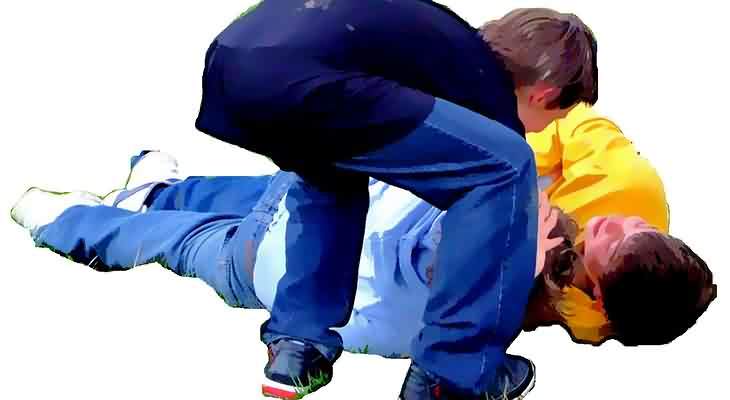
Scuffling and wrestling: there are many wrestling games that involve a lot of movement and fun.
©: www.youthwork-practice.com
What is the difference between fighting, scuffling and / wrestling?
Basically, it is important in which manner can physically compete with each other. There are two different ways: fighting versus wrestling and scuffling.
Wrestling and scuffling take place in a relatively safe environment with previously agreed and for both sides applicable and binding, rules so that no one gets hurt.
In addition, the boys and girls are not enemies, but friends or at least a partners. Wrestling and scuffling are more about measuring one’s strength and skills in a playful manner. There is no intention of hurting the other kid. Another thing is, the scuffling is not determinate as soon as one child has lost. Quite on the contrary, there can be several rounds added. There is a chance to get better and learn. Defeat can be an incentive to do better the next time. The most important thing, though, after the wrestling, the kids are still friends.
Fighting, on the other hand, is rather brutal. This is really about hurting somebody else. There are no pre-arranged rules, and the fight is only then finished when somebody gets hurt or starts crying. This can have the consequence, that both parties hate each other afterwards and are “enemies for life.” There are no second rounds or chances.
What can be learned while fighting, scuffling and wrestling?
Whether in the family by the mother, in kindergarten by the educator or in primary school by the teacher - in this day and age, children are mostly educated, women. And women refuse physical violence almost always. Therefore, young people are hardly able to wrestle anymore. Ultimately, this is can be detrimental to their development.
While scuffling, boys and girls learn to respond adequately to threats by defending themselves. This opens a door fort those kids to be much less likely to be forced into victimhood. Moreover, such conflicts teach to put oneself into somebody else’s shoes, which eventually will lead to compassion and mutual respect. It also teaches the skill to work together and promotes team spirit. After all, sometimes teams must be chosen for physical encounters.
Awareness of the own limitations and increased tolerance to frustration
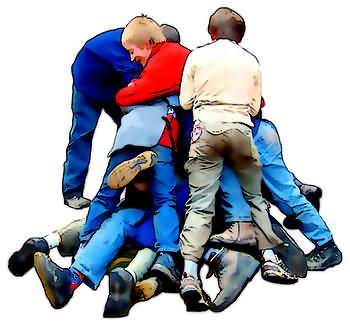
Scuffling and wrestling - not all games are harmless.
Therefore, please observe well and intervene when needed.
Especially then, when the game gets out of hand, someone cannot
breathe anymore, is crushed, because several kids are on top of him.
©: www.youthwork-practice.com
Also, many young people have no sense of their physical limitations, because they spend too much time playing computer games, and therefore get the limits of the most superhuman protagonists confused with their own. Thus, they take high risks (for example in the form of Dares). They tend to overestimate their own abilities. Wrestling and scuffling gets kids back into reality. They learn their own limitations and learn to accept them. Ultimately that will lead to defeats at times, which teaches the child, resilience to failure and not to give up as soon as things don’t go their way. The tolerance to frustration increases and the kid will learn to deal with failure and conflict
Cooperation- and communication skills, self-confidence and social skills
Some children tend to respond to threatening situations, assumed or real with uncontrolled violence if they have not learned to deal with such situations earlier. Wrestling and scuffling gives the children the opportunity to find their own rules and considerations when dealing with each other and difficult situations. Thus, they have at least one environment that they understand.
Wrestling is good for motor skills and concentration
While wrestling, young people develop the motor skills of their bodies. They learn to respond quickly, they learn about balance and force, which will help them to improve on other sports performances as well.
It is not unheard of that concentration problems and learning disabilities can be “treated” with wrestling. When wrestling or scuffling the children have to be focused, react quickly, often in a split second to exploit the weakness of their opponents. Concentration and reactivity are immensely encouraged in those wrestling games. Tactics, endurance, strength, levering techniques and willpower will be in great demand in the attempt to win.
More self-esteem and courage
Scuffling and wrestling, eventually, will lead to a higher self-esteem, girls and boys are more accepted within the group, which is paramount for young people. After all the circle of friends in for teenagers more influential than the family.
Wrestling and scuffling lead to more courageous boys and girls. After all, they are exposing oneself to potentially dangerous situations which could lead to injuries. When they see, they can survive the fight and flourish; basic trust will grow.
While fighting, they recognise their own weaknesses
The Austro-American philosopher, sociologist and psychotherapist Watzlawick, once said that you cannot communicate, cannot have a “dual encounter,” - this he also referred to the scuffling and fighting games of children. What he meant with that was, that, with every physical encounter, you not just learn about the other person but about yourself as well. Thus, revealing their own strengths and weaknesses. Consequently, the latter then are particularly severely punished. – When the young person experiences defeat, which often goes hand in hand with pain. This, in turn, inspires the kids to work on themselves to improve. Scuffling, therefore, is ideally suited to increase discipline and to deal with defeats – without responding with immediate aggressions.
Interesting too is, that children who were allowed to scuffle are less likely to resort to physical violence when dealing with adults. If they have learned to wrestle in a safe environment, they will have learned and internalised that “No” translates into “Stop immediately.” Responsibility for each other, consideration and respect for the integrity of others are also important areas of learning.
Wrestling and scuffling within the child and youth work

Arm Wrestling: find out who is stronger
©: www.youthwork-practice.com
Since physical fights contribute so much to the development of children, they should be allowed within the work with children and young people. Finally, all the boys and girls have the urge to fight, and this is best satisfied under supervision. Otherwise, the fun quickly can turn serious and injuries and frustration results from it.
Of course, reasonable rules have to be established. The main one is that one should never inflict pain on the “enemy” and that the scuffling ends when one of the two does not want to go on any longer. If the scuffling gets out of hand, action must be taken immediately.
Offer conflicting calls & conflict resolution
Ideally, the youth worker takes advantage of such situations to teach children about conflict resolution. For example, one might suggest resolving the dispute by less dangerous games like arm wrestling or a conversation.
Games around the Wrestling, Scuffling & Fighting
Here are a few games that seem appropriate to me for kids to compete, fight, wrestle or scuffle. These are all games with a lot of "body contact" and "physical effort". All those games are delivered in the appropriate framework and will not lead to any real fights, even if some tears are shed. But that happens with other games, such as Ball Games or Relay Races as well. And of course, the same is applies here as well, in case you think one or the other games are unsuitable, just select those games you would play as well.
Each game has its own rules which are very closely observed by the team leader. At the slightest sight for a situation to get out of hand, the team leader intervenes. If the occasion arises, it would be great if you could implement a feedback session afterwards to give everyone the opportunity to tell their take on the wrestling and scuffling games.
- How did I do?
- How did I feel about defeat or victory?
- Did I experience anger or aggression?
- On what did you think during the fight?
- Were you scared? What did scare you?
- What is the difference between wrestling and scuffling?
- What did we learn today?

Rider’s battle: every man for himself
©: www.youthwork-practice.com
-
Rider’s Battle:
Divide the group into teams of two kids each. Each pair of riders tries to toss over the opponent riders. The pair, where the rider touches the ground first, loses. Caution: don’t play the game on a hard ground with stones. Best suited is a sandy beach or green meadow.
-
King game:
For this game, you will need two teams. One kid of each team is the king, while some other kids are the “Castle” around him to protect their kind. The objective is to catch the king of the other team. This game requires attack, guarding and a few tactics. The size of the playground should not be greater than a football field.
-
Field Combat:
For This game, you will need to mark 5 4x6m fields on the lawn. One next to the other. You can use sawdust for the marking. The objective is to push the kid next to you into the next field while at the same time, getting not pushed out of your own field. That is a 1:1 combat. That goes on until there is only one winner left at the end.
-
Pushing through the circle:
First, create a circle of 2 -3m diameter. Two kids enter the circle, trying to push one another out of the circle. The winner takes on the next kid. Who has the most points at the end?
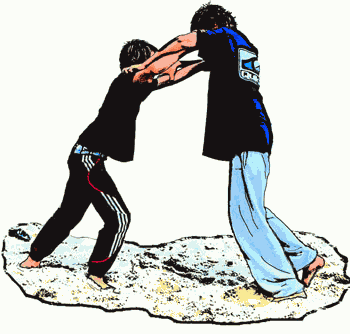
Classical wrestling
©: www.youthwork-practice.com
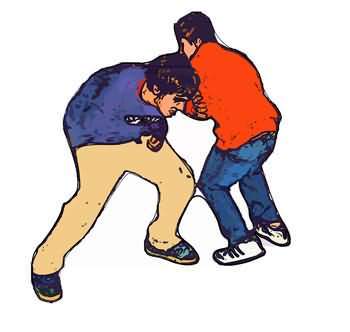
Pushing through the circle: pushing your opponent out of the circle
©: www.youthwork-practice.com
-
Wrestling:
The classic wrestling match within a marked field.
-
Sack Hitting:

Sack Hitting: beat the opponent from the field.
©: www.youthwork-practice.com2 fighters stand opposite each other. Each fighter moves in a 2x1 meter large field, which he is not allowed to leave. Each of them has a jute- or potato bag filled with straw. With this “weapon” they are supposed to beat each other out of balance and out of their respective play field.
-
Push up fight:
2 fighters face each other in the push-up position. The objective is to push the opponent’s hand away from under his body so that he falls on his belly while at the same time not losing balance oneself.
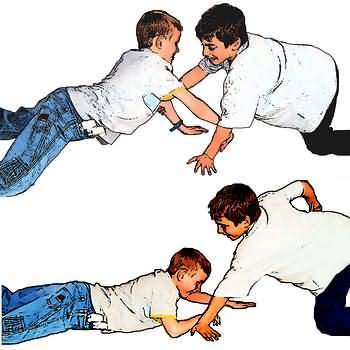
Push up fight: bring the enemy off balance.
©: www.youthwork-practice.com
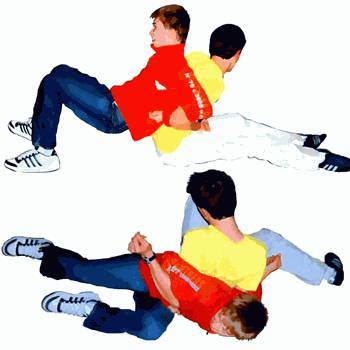
Back to back fight: turn the opponent on his belly
©: www.youthwork-practice.com
-
Back to back:
2 fighters are sitting back to back, having their arms hooked into each other. The objective is to turn the other one over on his belly.
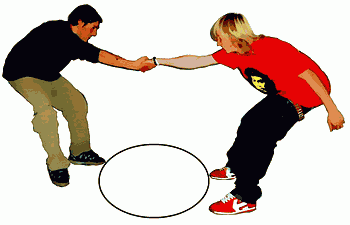
Pull your opponent into a circle.
©: www.youthwork-practice.com
-
Circle drawing:
Two opponents holding each other’s arms, trying to pull each other into the circle. Alternatively, you can also provide a cone or plastic bottle. Whoever touches the bottle/cone loses the game.
-
Rugby:
Rugby is a game where it can get a little rough. However, this is not just a wrestling game; it is a running game as well. Speed and physical effort are required.
-
Arm wrestling:
Instead of beating one another up, there is another way to find out one’s strength. Arm wrestling is one of those games. If you can prove your strength this way, without ever hitting someone this will give you respect by your peers.

Jousts: pushing one another of a bench with a padded lance
©: www.youthwork-practice.com
-
Jousts:
2 fighters face each other on a bench (or crate). Each of them receives a padded lance. The objective is trying to push one another off the bench. Even there is not wrestling; this will require a lot of skill and balance.
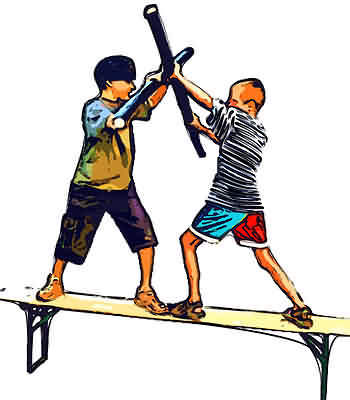
Stock fight: pushing one another off of a bench with a padded stick
©: www.youthwork-practice.com
-
Stick Fight:
The objective of this game is to push one another off of a box using a padded stick. For example, a broomstick would be perfect. To get rid of excess energy
There are a lot of games to get rid of excess energy which gets the kids really going but do not involve wrestling.
- Breaking the chain
- Tug of War
- Ball Games
- Running Games
Diese Artikel könnten zum Thema ebenfalls noch gut passen:
- Aggressive behaviour in children and adolescents
- Hyperactivity in children and adolescents
- Children should not be too obedient
- Dispute between children or teenagers
- Violent children and adolescents
- Dares - Test of Courage
- Mud fight
- Violence Prevention
- Dispute Resolution
[ © www.youthwork-practice.com | 2000 Games and Ideas for Youth Work ]






